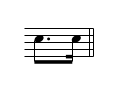Precise execution of dotted rhythms

Many of us have a tendency to play dotted rhythms (such as a dotted 8th note followed by a 16th note) inaccurately. The most cases fall in to these two categories:
- A. we make them into triplets
- B. we clip the dotted note too short
Let's look at what the causes are, and come up with solutions.
A. Dotted rhythms are not triplets

We know the difference between triplets and dotted rhythms. Yet, often we don't play the dotted rhythms correctly and they end up sounding like triplets. Causes are:
- lack of subdivision in counting
- Short note comes in too early
- too much bow is used for the short note, making it too long
1. Lack of subdivision

We should always subdivide in our head when we are playing dotted rhythms. If we are playing a dotted 8th note followed by a 16th note, we should subdivide in 16th notes, so the long note gets three 16th notes while the short note gets one. Without the subdivision our sense of rhythm becomes lazy, and we end up playing them more like triples.
2. Short note comes in too early
We tend to clip the dotted note short, and we allow the next short note to come in too early. This results in a triplet like figure.
The first remedy to this is to hold the dotted note long enough. Then, wait before you play the short note. You might be tempted to play the short note right away, but wait!
3. Too much bow is used for the short note, making it too long
Here is an obvious statement; "Short notes should be played short". Yet, when you evaluate how you are playing, you might notice that the short notes are not played short enough. This happens often when too much bow is used for the short note.
When we use a lot of bow we use the forearm. The problem with using the forearm is that it will not respond as quickly as fingers or wrist would respond. Arm muscles are not the ideal muscles when it comes to a quick turnaround. So when we use the forearm to play short notes, we are setting ourselves up for a slower response time. By using too much bow and having a slow response, the short note becomes too long, turning a dotted rhythm into a triplet.
The first thing you can do to fix this problem is to stop using the arm when you play the short note of a dotted rhythm. Instead, play the short note with your wrist or fingers, without moving your arm. This should do the trick.
When we use only the fingers and wrist, the range of motion gets limited, so it is difficult to use a lot of bow which is a good thing for this instance. Plus, the fingers and wrist can move rapidly in opposite directions, making it ideal for playing short notes.
B. There is no rest written in dotted rhythms
Another tendency we have when we play dotted rhythms is that we play the dotted note too short. As a result we make a big pause before the short note. It sounds like there is a rest between the long and short notes.

This time the rhythm is not coming out as a triplet. The timing of the short note is right but the length of the first note is not what is written on the music. This happens because we try to articulate the short note. However, as a self-respecting violinist, we should distinguish articulating the short note from making a rest before the short note.
Here is what we do to fix the problem.
Play a quarter note if it is written a dotted 8th note.
1. The first thing you should do is to make yourself play the dotted note long. So if there is a dotted 8th note and a 16th note rhythm, practice by playing the dotted 8th note as if it is a quarter note. When you do this, do not play the 16th note, yet. Just play the dotted 8th notes as quarter notes. Don't make it a tenuto on the quarter note. More like a swift quarter note where the tone almost disappears at the end.
2. Once you can do that, then keep playing the quarter note, only this time you are going to add a 16th note right before the quarter note disappears. If you time it right, you will have a good length on the dotted 8th note followed by the 16th note all within the length of a quarter note altogether. Below is an example of how you can apply this practice method in real life.

In order to play the dotted rhythm accurately, this is how we should first practice.

Use a fast bow speed, especially in the beginning of the quarter notes, then let them naturally decay. The quarter notes should almost disappear before you play the 2nd beat.
Now, maintain everything the same, and throw in the 16th note at the very last second before you play the 2nd beat. The music should sound as written originally, with an accurate presentation of the dotted rhythms.